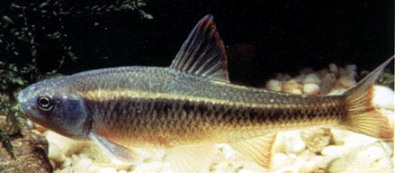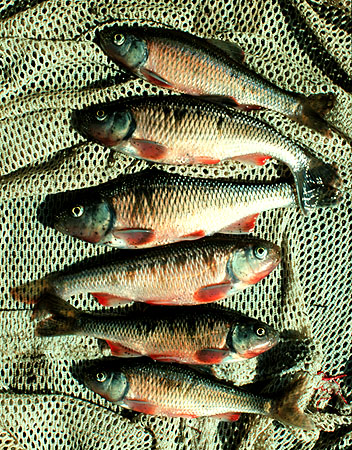Luxilus cornutus - BIO203
Reproduction of Luxilus cornutus
The common shiner is predominately a stream spawning fish. As
mentioned in the
habitat page, however, it does live in inland lakes and will therefore also spawn over gravel shoals. Most of the
time, the male shiner will actually use a fish bed that was previously
made by another fish, most often the bed of another creek shrub. If a shiner builds
their own nest, the male will excavate depressions in the sand or gravel
and allow the female to lay her eggs there. The eggs the female lays are actually
adhesive and will lodge against the substrate to ensure that they do not
flow away. The fecundity, or number of eggs laid, of females is closely
related to her body weight. The number of eggs that a female will lay
can be anywhere from 500 up to as many as 2000!
lakes and will therefore also spawn over gravel shoals. Most of the
time, the male shiner will actually use a fish bed that was previously
made by another fish, most often the bed of another creek shrub. If a shiner builds
their own nest, the male will excavate depressions in the sand or gravel
and allow the female to lay her eggs there. The eggs the female lays are actually
adhesive and will lodge against the substrate to ensure that they do not
flow away. The fecundity, or number of eggs laid, of females is closely
related to her body weight. The number of eggs that a female will lay
can be anywhere from 500 up to as many as 2000!
 The spawning will last 10-20 days during the day time and occurs from
late May to early July. During these months, it is seen that water
quality is the best for what the shiner needs to reproduce. A good water
quality is critical to ensure a good spawn. Water quality includes many
things, but the most important are water temperature, pH, and turbidity.
If temperature during the time of spawning and incubation changes for
the worse, it will most likely play a major role in the failure of the
egg's survival. Another factor in the production of the eggs are both
the dominant substrate and the wind action. These two factors play a
pivotal role in determining the amount of oxygen available to the
developing embryo.
The spawning will last 10-20 days during the day time and occurs from
late May to early July. During these months, it is seen that water
quality is the best for what the shiner needs to reproduce. A good water
quality is critical to ensure a good spawn. Water quality includes many
things, but the most important are water temperature, pH, and turbidity.
If temperature during the time of spawning and incubation changes for
the worse, it will most likely play a major role in the failure of the
egg's survival. Another factor in the production of the eggs are both
the dominant substrate and the wind action. These two factors play a
pivotal role in determining the amount of oxygen available to the
developing embryo.
The common shiner will usually chose to spawn at the beginning or end of a riffle. A riffle is an area in a stream that is a little more rapid moving water than other areas. After spawning, the adults will return to deeper pools where they normally reside. Some care of the eggs by the male includes guarding their nest loosely by using the tubercles on his head as a means of defense. After hatching, the juvenile shiner will drift down the riffle and spend most of their time in calm and more shallow waters. The shiner's life span will last approximately four to six years long.
Go back home, or get to know some of the ways that the common shiner interacts with some other organisms.